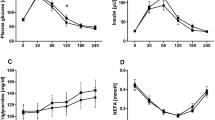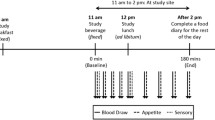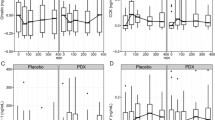Abstract
Purpose
Polydextrose is a low-calorie highly branched-chain glucose polymer that is poorly digested in the upper gastrointestinal tract and therefore demonstrates fibre-like properties. Fibre has been shown to increase satiety and possibly reduce food intake. Therefore, the objective of the current study was to examine the effects of polydextrose on short-term satiety and energy intake.
Methods
In a repeated-measures randomized blind cross-over design, 26 healthy males consumed a 400-g fruit smoothie containing 12 g (3 %) of polydextrose, and a buffet lunch 60 min after the smoothie. Motivational ratings for satiety and palatability and lunch energy intake were measured. The effects of the polydextrose-containing smoothie were compared against a polydextrose-free control smoothie.
Results
Polydextrose did not significantly alter the taste and palatability of the fruit smoothie. Consuming the polydextrose-containing smoothie resulted in a significantly lower energy intake at lunch (102 kcal less) compared to the control.
Conclusion
Polydextrose may be a good fortificant for reducing short-term food intake.

Similar content being viewed by others
References
Craig SA, Holden JF, Khaled MY (2000) Determination of polydextrose as dietary fiber in foods. J AOAC Int 83:1006–1012
Raninen K, Lappi J, Mykkanen H, Poutanen K (2011) Dietary fiber type reflects physiological functionality: comparison of grain fiber, inulin, and polydextrose. Nutr Rev 69:9–21. doi:10.1111/j.1753-4887.2010.00358.x
Hengst C, Ptok S, Roessler A, Fechner A, Jahreis G (2009) Effects of polydextrose supplementation on different faecal parameters in healthy volunteers. Int J Food Sci Nutr 60(Suppl 5):96–105
Jie Z, Bang-Yao L, Ming-Jie X, Hai-Wei L, Zu-Kang Z, Ting-Song W, Craig SA (2000) Studies on the effects of polydextrose intake on physiologic functions in Chinese people. Am J Clin Nutr 72:1503–1509
Yoshioka M, Shimomura Y, Suzuki M (1994) Dietary polydextrose affects the large intestine in rats. J Nutr 124:539–547
Goff D, Jordan W (1984) Aspartame and polydextrose in a calorie-reduced frozen dairy dessert. J Food Sci 49:306–307
Blundell JE, Burley VJ (1987) Satiation, satiety and the action of fibre on food intake. Int J Obes 11(Suppl 1):9–25
Slavin JL, Green H (2007) Dietary fibre and satiety. Nutr Bul 32:32–42
King NA, Craig SA, Pepper T, Blundell JE (2005) Evaluation of the independent and combined effects of xylitol and polydextrose consumed as a snack on hunger and energy intake over 10 d. Br J Nutr 93:911–915
Monsivais P, Carter BE, Christiansen M, Perrigue MM, Drewnowski A (2011) Soluble fiber dextrin enhances the satiating power of beverages. Appetite 56:9–14
Willis HJ, Eldridge AL, Beiseigel J, Thomas W, Slavin JL (2009) Greater satiety response with resistant starch and corn bran in human subjects. Nutr Res 29:100–105
Baecke JOH, Burema J, Frijters JER (1992) A short questionnaire for the measurement of habitual physical activity in epidemiological studies. Am J Clin Nutr 36:936–942
Van Strien T, Frijters JER, Bergers GPA, Defares PB (1986) The Dutch Eating Behavior Questionnaire (DEBQ) for assessment of restrained, emotional and external eating behavior. Int J Eat Disord 5:747–755
Ranawana DV, Henry CJ (2010) Are caloric beverages compensated for in the short-term by young adults? An investigation with particular focus on gender differences. Appetite 55:137–146
Nielsen SJ, Popkin BM (2003) Patterns and trends in food portion sizes, 1977–1998. JAMA 289:450–453
Benelam B (2009) Satiation, satiety and their effects on eating behaviour. In: Nutrition bulletin-briefing paper. British Nutrition Foundation, London
Livingstone MBE, Robson PJ, Welch RW, Burns AA, Burrows MS, McCormack C (2000) Methodological issues in the assessment of satiety. Scand J Nutr 44:98–103
Anderson GH, Catherine NLA, Woodend DM, Wolever TMS (2002) Inverse association between the effect of carbohydrates on blood glucose and subsequent short-term food intake in young men. Am J Clin Nutr 76:1023–1030
Birch LL, McPhee L, Sullivan S (1989) Children’ food intake following drinks sweetened with sucrose or aspartame: time course effects. Physiol Behav 45:387–395
Friedman MI (2008) Food intake: control, regulation, and the illusion of dysregulation. In: Harris RBS, Mattes RD (eds) Appetite and food intake: behavioral and physiological considerations. CRC Press, Boca Raton
FAO/WHO (1998) Carbohydrates in human nutrition—report of a joint FAO/WHO expert consultation. Food and Agriculture Organisation, Rome
Holland B, Welch AA, Unwin ID, Buss DH, Paul AA, Southgate DAT (1991) McCance and Widdowson’s composition of foods. The Royal Society of Chemistry, Cambridge
Davy BM, Van Walleghen EL, Orr JS (2007) Sex differences in acute energy intake regulation. Appetite 49:141–147. doi:10.1016/j.appet.2007.01.010
Bryant M, Truesdale KP, Dye L (2006) Modest changes in dietary intake across the menstrual cycle: implications for food intake research. Br J Nutr 96:888–894
Buffenstein R, Poppitt SD, McDevitt RM, Prentice AM (1995) Food intake and the menstrual cycle: a retrospective analysis, with implications for appetite research. Physiol Behav 58:1067–1077
Lissner L, Stevens J, Levitsky DA, Rasmussen KM, Strupp BJ (1988) Variation in energy intake during the menstrual cycle: implications for food-intake research. Am J Clin Nutr 48:956–962
Del Parigi A, Chen K, Gautier JF, Salbe AD, Pratley RE, Ravussin E, Reiman EM, Tataranni PA (2002) Sex differences in the human brain’s response to hunger and satiation. Am J Clin Nutr 75:1017–1022
Diaz S, Farhang B, Hoien J, Stahlman M, Adatia N, Cox JM, Wagner EJ (2009) Sex differences in the cannabinoid modulation of appetite, body temperature and neurotransmission at POMC synapses. Neuroendocrinology 89:424–440. doi:10.1159/000191646
Gayle DA, Desai M, Casillas E, Beloosesky R, Ross MG (2006) Gender-specific orexigenic and anorexigenic mechanisms in rats. Life Sci 79:1531–1536. doi:10.1016/j.lfs.2006.04.015
Greenman Y, Golani N, Gilad S, Yaron M, Limor R, Stern N (2004) Ghrelin secretion is modulated in a nutrient- and gender-specific manner. Clin Endocrinol (Oxf) 60:382–388
Hagobian TA, Sharoff CG, Stephens BR, Wade GN, Silva JE, Chipkin SR, Braun B (2009) Effects of exercise on energy-regulating hormones and appetite in men and women. Am J Physiol Regul Integr Comp Physiol 296:R233–R242. doi:10.1152/ajpregu.90671.2008
Havel PJ (2001) Peripheral signals conveying metabolic information to the brain: short-term and long-term regulation of food intake and energy homeostasis. Exp Biol Med (Maywood) 226:963–977
de Castro JM (1987) Circadian rhythms of the spontaneous meal pattern, macronutrient intake, and mood of humans. Physiol Behav 40:437–446
Anderson GH (1995) Sugars, sweetness, and food intake. Am J Clin Nutr 62:195S–201S; discussion 201S–202S
Auerbach M, Craig S, Mitchell H (2006) Bulking agents: multifunctional ingredients. In: Mitchell H (ed) Sweeteners and sugar alternatives in food technology. Blackwell, Oxford
Anon (2005) STA-LITE® polydextrose—product information brochure. Tate and Lyle, London
Mattes RD, Rothacker D (2001) Beverage viscosity is inversely related to postprandial hunger in humans. Physiol Behav 74:551–557
Cleary LJ, Andersson R, Brennan CS (2007) The behaviour and susceptibility to degradation of high and low molecular weight barley β-glucan in wheat bread during baking and in vitro digestion. Food Chem 102:889–897
Chillo S, Ranawana DV, Pratt M, Henry CJ (2011) Glycemic response and glycemic index of semolina spaghetti enriched with barley beta-glucan. Nutrition 27:653–658. doi:10.1016/j.nut.2010.07.003
Stubbs RJ, Hughes DA, Johnstone AM, Rowley E, Reid C, Elia M, Stratton R, Delargy H, King N, Blundell JE (2000) The use of visual analogue scales to assess motivation to eat in human subjects: a review of their reliability and validity with an evaluation of new hand-held computerized systems for temporal tracking of appetite ratings. Br J Nutr 84:405–415
Canty DJ, Chan MM (1991) Effects of consumption of caloric vs noncaloric sweet drinks on indices of hunger and food consumption in normal adults. Am J Clin Nutr 53:1159–1164
DellaValle DM, Roe LS, Rolls BJ (2005) Does the consumption of caloric and non-caloric beverages with a meal affect energy intake? Appetite 44:187–193. doi:10.1016/j.appet.2004.11.003
Raben A, Tagliabue A, Astrup A (1995) The reproducibility of subjective appetite scores. Br J Nutr 73:517–530
Acknowledgments
The authors are grateful to Danisco A/S for facilitating the study through an unconditional grant and to the participants for taking part in the study. After the completion of the study Viren Ranawana joined the Singapore Institute for Clinical Sciences. Adelaide Muller was on a research placement at OBU and has since returned to her University, Polytech’Clermont-Ferrand, France.
Author information
Authors and Affiliations
Corresponding author
Rights and permissions
About this article
Cite this article
Ranawana, V., Muller, A. & Henry, C.J.K. Polydextrose: its impact on short-term food intake and subjective feelings of satiety in males—a randomized controlled cross-over study. Eur J Nutr 52, 885–893 (2013). https://doi.org/10.1007/s00394-012-0395-4
Received:
Accepted:
Published:
Issue Date:
DOI: https://doi.org/10.1007/s00394-012-0395-4




